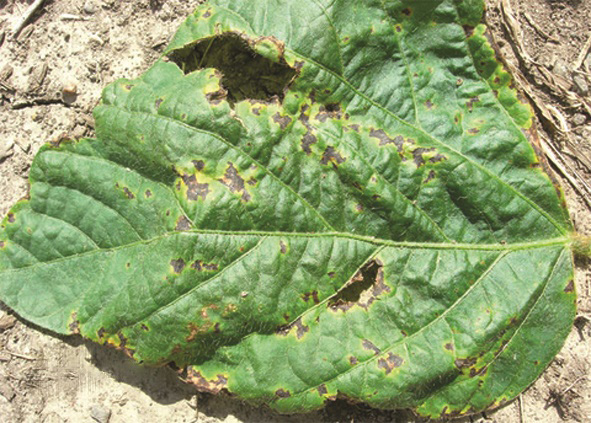
ARC-Grain Crops,
Potchefstroom

Dr Belinda Janse
van Rensburg,
ARC-Grain Crops,
Potchefstroom

Dr Bradley Flett,
ARC-Grain Crops,
Potchefstroom
Soybean is an excellent crop that can be included into a maize-based crop rotation system. Prior to soybeans becoming a regular crop in rotation with maize, South Africa was a net importer. The growing need for soybean proteins and oils is evident by the increased amount of land dedicated for its production over the past three decades. However, many diseases, including those brought on by bacteria, can limit crop yields and reduce crop profitability.
In terms of yield and area, Mpumalanga ranks first, KwaZulu-Natal second and the Free State third in the production of soybeans (Glycine max L.). Irrespective, the Northwest Province, Gauteng and Limpopo also have great potential to contribute to the increase in soybean production.
In South Africa, research has focused primarily on the fungi that cause diseases in soybeans, while bacterial infections are less understood. Although not yet officially reported in South Africa, international seed trade can increase the risk that any of these diseases may be introduced into the country. Favourable environmental conditions may further promote the potential growth and spread of these introduced diseases.
It is worth noting that plants can be infected at any time during the growing season. Cool, wet weather and rainstorms favour development of these diseases, but dry, hot conditions will restrict disease progress. Bacterial diseases are generally seedborne, which means that the pathogen can infect uninfected fields through the planting of infected seeds. These pathogens can also be spread over shorter distances by windblown rain, rain splash and machinery during wet conditions. Crop residue, seed and alternate hosts may retain these phytopathogenic bacteria and serve as a primary inoculum source.
This article’s aim is to provide producers with information regarding disease identification and management options. Producers are requested to keep an eye on soybean production fields for any of the symptoms described here. If any of these symptoms are discovered or identified, producers are requested to send affected plants to the authors for isolation and identification of the disease-causing agents. Correct and early disease identification can ensure timeous application of control measures, which may include quarantining areas where the disease is initially found to prevent further spread and initiation of testing seed lots for possible infected seed batches. This will give local researchers adequate time to obtain international knowledge on the epidemiology and control of the diseases. These may include various practices including bactericides, cultural control measures and resistance breeding programmes.
The quickest, easiest and possibly the first control measure which can be implemented, would be the use of a bactericide, since a fungicidal application will not control a bacterial disease. The implementation of cultural control and resistance is time-consuming as researchers first need to understand the epidemiology and impact of the disease under local conditions. Breeding programmes for resistance are timeous and may take years to develop resistant hybrids adequate for South African conditions.
This article will focus on the three most significant bacterial diseases of soybeans globally, which are bacterial blight (caused by Pseudomonas savastanoi pv. Glycinea), bacterial pustule (caused by Xanthomonas axonopodis pv. Glycines) and wildfire (caused by Pseudomonas syringae).
Bacterial blight
Infected seedlings may be stunted or killed in severe cases. Bacterial blight can occur on all above-ground plant parts, but is most evident on leaves residing in the mid to upper canopy. Infections start as small angular, water-soaked spots that turn yellow to light brown as the tissue starts to die (Photo 1). The spots darken and are surrounded by yellowish-green halos. Spots often merge to form large, dead patches on the leaves. The dead tissue may fall out and cause the leaves to have a ragged appearance (Photo 2). Infected leaves usually remain on the plant. Infection can also occur on stems, petioles, pods and seeds from infected pods.

Photo: D Mueller

Photo: M Chilvers, MSU
Bacterial blight can easily be mistaken for Septoria brown spot (caused by the fungus Septoria glycines) (Photo 3). However, bacterial blight lesions will always have a distinguished halo around the lesions that will be absent in Septoria brown spot. Both diseases can occur on the same plant, but bacterial blight is most common on young leaves whereas Septoria brown spot is usually seen on the older, lower leaves. In the laboratory these two diseases can easily be distinguished by observing the lesions using a microscope, by plating the sample out on selective media and through sequencing.

Photo: M Chilvers, MSU
Bacterial pustule
Bacterial pustule disease symptoms start as small, light green spots that are not water-soaked like the pustules of bacterial blight. These green spots have raised centres on the upper and lower surfaces of leaves, hence the name pustule. Light-coloured pustules (blisters) often develop in the centre of lesions, particularly on the undersides of the leaves. Lesions can coalesce into large, irregular, brown areas that can tear away from the leaf (Photo 4). Small, raised spots may also develop on pods. The disease is carried over from one season to the next in infected leaf residue that stay behind in the field and with infected seed.

Photo: D Mueller
Wildfire
Wildfire disease is commonly associated with bacterial blight and pustule infection, but its lesions are often larger than that of other bacterial diseases and the disease favours wet and warm temperatures of 24 ºC to 28 ºC. It is a relatively uncommon bacterial disease in soybean, but can – under favourable conditions – reduce yield considerably. Symptoms consist of light-brown necrotic spots of variable size surrounded by broad, yellow halos on the leaves (Photo 5). In damp weather the lesions enlarge or coalesce to form large dead areas on the leaf. Dead tissue eventually falls off and leaves develop a tattered look (Photo 6). Severe infection may result in early defoliation, resulting in reduced yield.

Photo: T Faske

Photo: T Faske
Management of bacterial diseases
Disease management strategies aim to favour the host plant’s growth and development, while attacking vulnerable stages in the lifecycle of the pathogen to prevent or restrict its development. To achieve this goal an integrated disease management programme includes the following key means of bacterial disease management:
-
- Planting of certified, pathogen-free seed, which is the preferred, initial management tool.
- Planting of disease-tolerant (resistant) soybean cultivars and varieties, particularly in fields with a history of the disease. This will reduce epidemics to such a degree that yield losses are minimal.
- Cultural practices that include the following:
- Crop rotation systems that include non-host crops such as maize to avoid inoculum from a previously infected crop.
- Residue management and tillage to remove infested soybean residue on which the bacteria can overwinter. The risk of disease can be reduced by ploughing or grazing. Cultivation should be avoided when foliage is wet.
- Bactericides or chemicals that contain copper are readily available and generally cheap, but should only be used on fields with a history of bacterial infections. In areas that are especially prone to bacterial diseases, these can be applied preventatively during the late vegetative or early flowering stages. Once symptoms are already obvious, it will be too late for the chemicals to effectively prevent the disease, but it will slow down the spread.





























